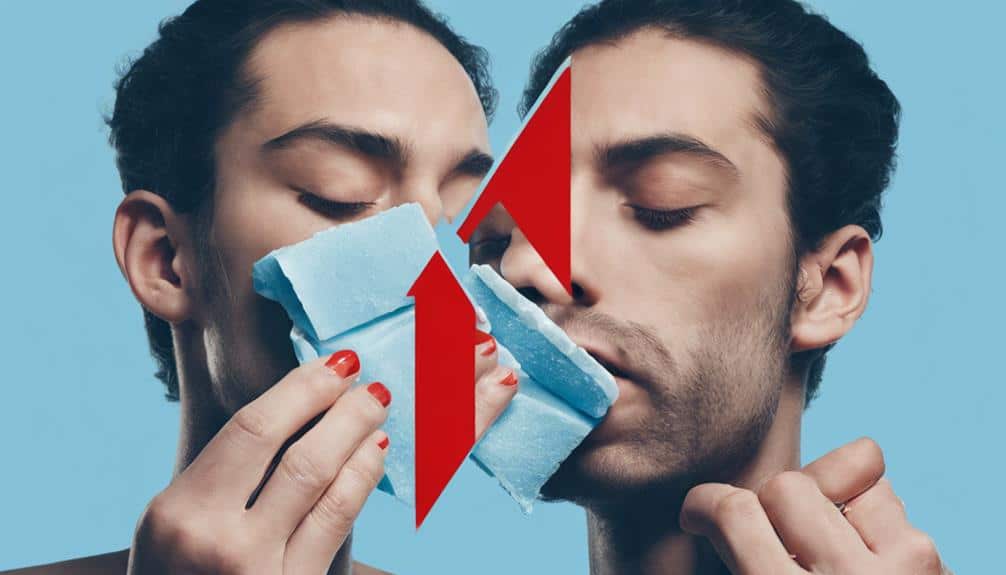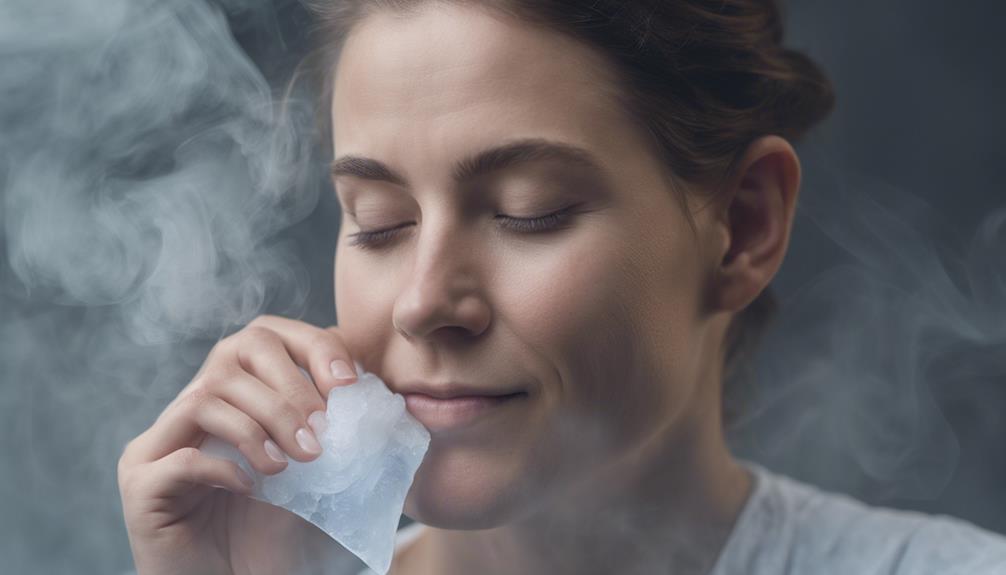You'll want to be cautious when smoking after a tooth extraction to avoid dry socket, a painful condition that's more common in smokers. Wait 48-72 hours before resuming smoking to allow for proper clot formation. Consult your dentist first, and avoid deep inhalation to minimize the risk. Consider alternative nicotine sources, like patches or gum, and maintain good oral hygiene practices. Focus on managing pain and discomfort with clove oil-soaked cotton balls and salt water rinses. By taking these precautions, you can reduce your risk of dry socket and guarantee a smoother recovery – and there's more to explore to ensure a successful healing process.
Key Takeaways
• Wait at least 48-72 hours after tooth extraction to allow for proper clot formation before resuming smoking.
• Avoid deep inhalation to reduce the risk of dislodging the blood clot and developing dry socket.
• Consider alternative nicotine consumption methods like nicotine patches, gum, or lozenges to reduce the urge to smoke.
• Practice good oral hygiene, including gentle brushing and staying hydrated, to support overall healing and reduce dry socket risk.
• Refrain from smoking heavily and frequently, as this can increase the risk of dry socket and impede the healing process.
Delayed Healing and Risks
By smoking after a tooth extraction, you're effectively impeding your body's natural healing process, which can lead to a range of complications that may prolong your recovery. When you smoke, you reduce blood flow and oxygen supply to the wound site, delaying the healing process. This increases the risks of developing dry socket, a painful condition that occurs when the blood clot that forms after dental extraction is dislodged, exposing the bone and nerves.
As a smoker, you're more likely to experience dry socket, with up to 12% of smokers developing this complication compared to 4% of non-smokers. Smoking also increases the risk of infection and pain after tooth extraction. To maintain good oral health and prevent dry socket, it's crucial to understand the risks of smoking post-extraction.
Precautions Before Smoking Again

Before you resume smoking after a tooth extraction, it's important to take precautions to minimize the risks of complications and guarantee proper healing. First, wait for at least 48-72 hours post-extraction to allow for proper clot formation.
It's also vital to consult your dentist to monitor your healing progress before resuming smoking. When you do start smoking again, avoid deep inhalation, as it can dislodge the blood clot and lead to dry socket. Consider alternative nicotine consumption methods, such as nicotine gum or lozenges, to reduce the risk of complications.
Additionally, maintain good oral hygiene practices, such as gentle brushing and flossing, to minimize the risk of infection. By taking these precautions, you can reduce the risks associated with smoking after a tooth extraction and promote proper healing.
Managing Pain and Discomfort

Effective pain management is crucial during the recovery period after a tooth extraction, as it enables you to better cope with discomfort and promote a smoother healing process. You'll want to manage pain and discomfort effectively to prevent dry socket and support a speedy recovery before resuming smoking after extraction.
For pain relief, try using clove oil-soaked cotton balls, which have natural analgesic properties. Additionally, rinsing with salt water can help alleviate discomfort post-extraction. If you experience severe pain, consider seeking dental intervention for irrigation and pain management. Your dentist may prescribe pain-relieving medications to help you cope with discomfort. To further manage pain, gauze dressings with medication can be changed daily.
Alternatives to Smoking Cigarettes

While you're recovering from tooth extraction, consider switching to nicotine patches or gum, which can provide a steady nicotine supply without the harmful effects of smoking. These alternatives can help manage cravings and reduce the urge to smoke, promoting better healing and reducing the risk of complications.
Here are three alternatives to smoking cigarettes:
- Nicotine Patches: These patches release a steady dose of nicotine into your system, decreasing the urge to smoke and aiding in recovery.
- Nicotine Gum: Chewing nicotine gum can serve as a substitute for cigarettes, helping to manage cravings and reduce the need for forceful inhalation.
- Other Alternatives like Nicotine: There are various alternatives like nicotine lozenges, inhalers, and prescription medications that can help reduce tobacco use and promote smoking cessation.
Oral Hygiene and Recovery

As you focus on quitting smoking, it's equally important to prioritize your oral hygiene and recovery after a tooth extraction, guaranteeing a smooth and complication-free healing process.
To maintain good oral hygiene, gently brush your teeth, avoiding the extraction site, to prevent any disruption to the healing process. Refrain from using mouthwash initially, as it can irritate the site and delay healing.
Stay hydrated to support overall healing and minimize the risk of complications. Avoid hard or crunchy foods that may irritate the extraction site during recovery.
It's crucial to be aware of the signs of dry socket, including severe pain, an empty socket, and bad breath, which require immediate dental attention.
By following these guidelines, you can reduce the risk of dry socket and promote excellent oral health.
Remember to change your gauze as directed, and avoid using tobacco products, including smoking, to ensure a smooth and speedy recovery.
Frequently Asked Questions
How to Avoid Getting Dry Socket but Still Smoke?
You're wondering how to avoid getting dry socket but still smoke after a tooth extraction. To minimize the risk, you'll want to take precautions. First, try to wait at least 48 hours after the tooth extraction before smoking. This will give the blood clot in the socket enough time to form and protect the area. When you do smoke, try to use gauze to cover the extraction site to minimize the suction. Additionally, consider asking your dentist about any smoking cessation methods that can help you quit in order to promote healing. And remember, smoking can also affect your oral health in other ways, such as staining your teeth, but there are ways to achieve white teeth in 1 day with professional whitening treatments.
Cover the extraction site with moist gauze while smoking to protect the wound. Avoid deep inhalation, which can dislodge the blood clot, and rinse your mouth gently with warm salt water after smoking to reduce bacteria.
How Can I Guarantee No Dry Socket?
Imagine a delicate dance of caution and care, where one misstep could lead to a painful dry socket. To guarantee no dry socket, you need a foolproof plan.
Here's the truth: there's no 100% guarantee, but by following the 5 tips, you'll greatly reduce the risk. Be diligent about waiting 72 hours, covering the extraction site, and rinsing with salt water.
Your diligence will pay off, and you'll be smoking safely in no time.
Will I Get Dry Socket if I Smoke With Gauze?
You're wondering if you'll get dry socket if you smoke with gauze.
The good news is that using gauze greatly reduces the risk of dry socket. By placing gauze over the extraction site, you're creating a barrier that prevents smoke from directly contacting the wound, promoting clot retention and healing.
How Do You Swallow to Prevent Dry Socket?
Did you know that over 5 million teeth are extracted annually in the US alone?
When it comes to swallowing to prevent dry socket, you're on the right track! To do it correctly, you swallow gently, avoiding vigorous movements that can dislodge the blood clot.
This gentle approach minimizes trauma to the socket, promoting healing and reducing the risk of dry socket.



